In 1964 gangs of Mods and Rockers fought battles on the very British beaches Winston Churchill had once sworn to defend.
It all kicked-off over the Easter weekend of 30th March in the holiday town of Clacton-on-Sea, south-east England. Famed for its cockles and winkles, “Kiss Me Quick” hats, amusement arcades, its eleven-hundred foot pier and golden sands on West Beach, Clacton provided the backdrop for the first major battle between the twenty-something Rockers and their teenage rivals the Mods. Clacton was reportedly “beat-up” by “scooter gangs” and 97 youth were arrested.
This was but a small rehearsal for what was to come later that year. Over the May and August bank holidays “skirmishes” involving over “thousands” of youngsters “erupted” at the seaside resorts of Margate, Broadstairs and Brighton.
In Margate there were “running battles between up to 400 teens and police on the beach as bottles were thrown amid general chaos.” But it was the fighting in Brighton that scooped the headlines, with tales of two days of “violence” and some “battles” moving further along the coast to Hastings.
The press latched onto the story of youth out of control like a terrier and squeezed every damning adjective out of it, hyping the events into a small war. Yet, these so-called “running battles” between the two rival factions were no worse than the fights between soccer fans or street gangs on a Saturday night. Still, the press and parts of the “establishment” (the police, the judges, the bishops, the local councillors and politicians…etc.) saw an opportunity to slap down the youth, and the press created a “moral panic” outraged over the falling standards of “this scepter’d isle.”
The Rockers were proto-biker gangs—they kept themselves separate from society, were bound by their own rules and rituals, and usually only fought with rival Rockers. Though considered dangerous—often referred to by the press as the “Wild Ones” after the American B-movie starring Marlon Brando—there was a sneaking admiration for the Rockers as they epitomised a macho fantasy of freedom and recklessness that most nine-to-five workers could only dream about. The Rockers also had the added appeal of being working class and fans of rock ‘n’ roll—which was more acceptable to middle England in the mid-sixties once the God-fearing Elvis had set youngsters a good example of being dutiful to one’s country by joining the US Army.
Mods on the other hand were an unknown quantity—ambitious, aspirant working class kids, politically astute, unwilling to take “no” for an answer. They were feared for their drug taking—speed was their tipple of choice—and their interest in looking good and wearing the right clothes. Dressing sharp was considered “suspect” and if not exactly effeminate, being fashion-conscious was not an attribute traditionally thought of as a masculine one. For an older generation, the Mods were the face of the future looming—the red brick universities, the council estate, the supermarkets, the motorways and self-service restaurants—these entitled brats were the very children for whom they had fought a war.
The events of that heady summer inspired The Who’s Pete Townshend to write his rock opera Quadrophenia. Anthony Burgess, who was never shy about making a headline, said his book A Clockwork Orange had been inspired by these “loutish” and “hoodlum” youth—even though his book had been published in 1962. Fifty years after the infamous “fighting on the beaches,” the BBC made a documentary revisiting the Mods, Rockers and Bank Holiday Mayhem that interviewed some of the youngsters who were there.
The intention of the filmmakers in this short extract from the “exploitation” documentary Primitive London is to take a pop at tribal youth culture and its fashions. The four youth cultures briefly examined are Mods, Rockers, Beatniks and those who fall outside of society.
The Mods are dismissed as “peacocks;” the Rockers are seen as lumpen and shall we say knuckle-dragging; the Beatniks don’t really know what they believe in as they are against everything, man; and finally there are the ones who are not part of any group as they consider themselves to be outside of society—apparently these guys “dissipate their identity in complete passivity”—now that sounds like a group I’d join.
Mostly it’s all about the Beatniks, who are filmed hanging out in their local bar getting drunk, answering questions on fashion, work, marriage and all the other concerns middle-aged producers thought were important in 1965. As a footnote, the bar seen in this clip is the one where Rod Stewart (aka Rod the Mod) hung out. The featured musicians are Ray Sone, harp (later of The Downliners Sect) and Emmett Hennessy, vocals, guitar.
It's in my eyes, and it doesn't look that way to me, In my eyes. - Minor Threat
Wednesday, February 18, 2015
The real Quadrophenia:
Mods vs. Rockers fight on the beaches
from Dangerous Minds

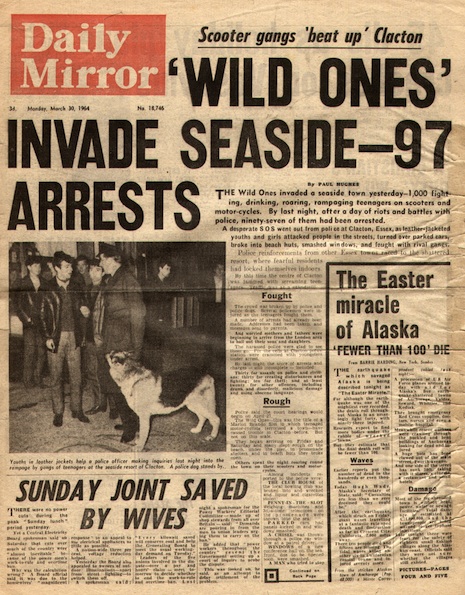
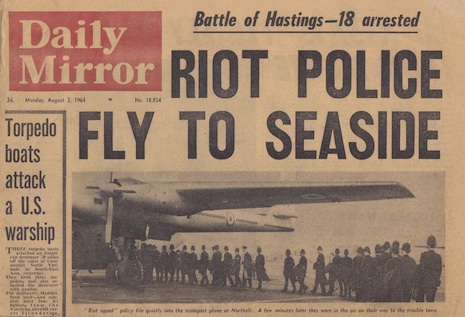

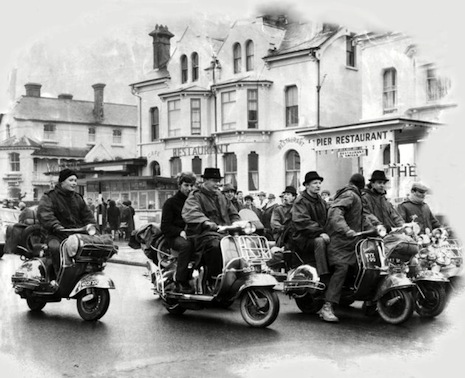

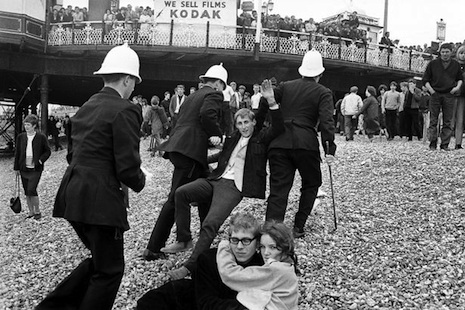
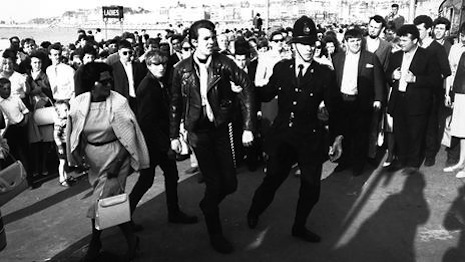

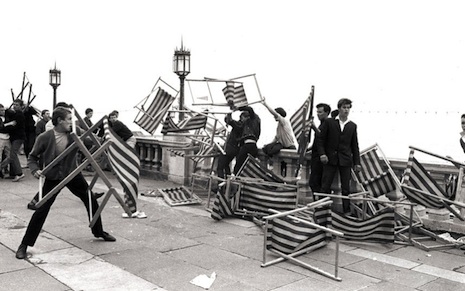
No comments:
Post a Comment